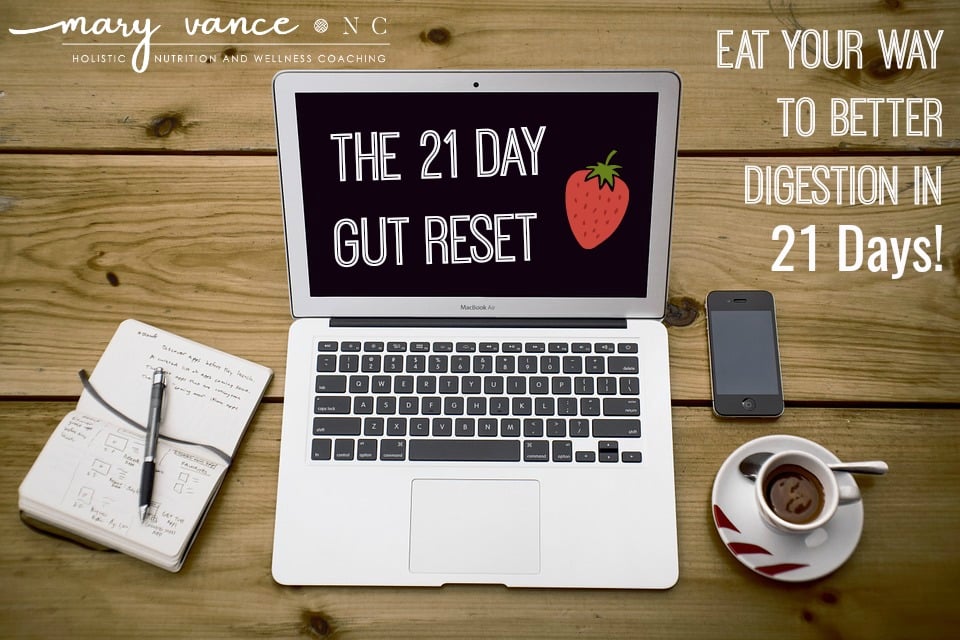Heartburn: It’s a warming or burning sensation you feel in your chest, most often behind your breastbone. It may worsen when you’re lying down or bending over. Also known as acid reflux, heartburn is caused by acids traveling up your esophagus (the tube that connects your mouth and your stomach) from the stomach.
Chronic heartburn is known as GERD, or gastroesophageal reflux disease. Heartburn is not only distracting and painful, but it can also signal problems with your digestive tract. The typical solution is to take antacids or proton pump inhibitors (PPIs), but these meds simply cover up the problem rather than correcting the root cause. GERD needs to be addressed or it can cause erosion of the esophagus which leads to ulcers.
You can overcome chronic GERD or heartburn by changing your diet and using supplements to heal gastric mucosa tissue. The protocol and strategies I’ve listed here are mainly designed to get rid of GERD, but for acute heartburn (that occurs rarely), you can use the suggestions below that will stop the pain/burning.
Approximately 7 million people in the U.S. have symptoms of GERD.
60% of the adult population will experience some type of GERD within a 12 month period. 20 – 30% will have weekly symptoms. (source) Heartburn can occur in infants, and, according to some estimates, about 2% of children ages 3 to 9, and 5% of children ages 10 to 17 experience heartburn, but it is increasingly common with age. (source)
It seems logical that heartburn is caused by too much stomach acid, but believe it or not, nearly all cases of chronic GERD are caused by low stomach acid, or hypochlorhydria, and antacids make the problem worse over time.
What Causes Heartburn?
Having too much stomach acid is actually rare. Excess stomach acid is only found in a few rare conditions like Zollinger-Ellison syndrome, and GERD is hardly ever associated with too much stomach acid. (source). Stomach acid declines with age; one study found that 40% of women over the age of 80 produce no stomach acid at all! So it doesn’t correlate that GERD increases with age while stomach acid decreases with age if the cause is too much stomach acid.
The true cause of most cases of GERD is hypochlorhydria, or low stomach acid.
When you eat something, digestion to break down starch begins in the mouth, then food travels down the esophagus and into the stomach, where hydrochloric acid (HCl) is released to break down proteins, fats, and carbohydrates. Then the chyme (mostly digested food blob) moves into the small intestine, where enzymes are released to liquify food for absorption from your small intestine into the bloodstream.
The pH of your stomach should be around 2.0 because of the HCl production. This is very acidic, and it needs to be to both break down food and kill any pathogens that may have hitchhiked in with your food.
In the case of hypochlorhydria, here’s what happens: You eat food; it travels to your stomach. HCl is produced (in most cases; elderly folks don’t produce enough, or sometimes none at all), but it is not acidic enough to break down food, and/or it is not secreted in the proper quantity. When HCl is too alkaline, the assimilation process (food being broken down into glucose, fatty acids, amino acids, and nutrients) can’t occur as it should, and digestion slows. Food (typically carbohydrates) ferments as it makes its way too slowly through the small intestine, and the gases from the fermentation travel up the esophagus and cause burning.
This issue is often structural: After food passes through your esophagus into your stomach, a muscular valve called the lower esophageal sphincter (LES) closes, preventing food or acid from moving back up. Reflux occurs when the LES relaxes inappropriately, allowing acid from your stomach to flow (reflux) backward into your esophagus. The fermentation pressure from slow digestion mentioned above can cause the LES to open.
Infrequent (not chronic, every once in a while) heartburn can be caused by certain trigger foods, alcohol, overeating, and fatty foods.
Antacids provide temporary relief because they neutralize the acid and/or gases resulting from slow digestion fermentation or a lazy LES. But antacids don’t solve the underlying cause of heartburn and can actually worsen hypochlorhydria by making stomach acid even more alkaline over time. PPIs block stomach acid production, but long term use is associated with serious side effects.
What Causes Hypochlorhydria?
- h pylori is one of the biggest causes. This pathogenic bacteria attaches itself to the stomach lining and secretes an enzyme to alkalize HCl so it can survive. Up to 50 percent of the world’s population is infected.
- taking antacids and PPIs such as Tums, Prilosec, Nexium
- age
- stress
- food intolerances or reactions (dairy, gluten, eggs, soy, coffee, alcohol are the major culprits)
- zinc deficiency (a big one). You need zinc to build HCl.
Symptoms of Hypochlorhydria
- Bloating after meals, or a feeling that food is just sitting in your gut
- Heartburn
- Constipation
- Belching and farting after meals
- Undigested food in stool
- Rosacea
- Indigestion
- Difficulty digesting red meat
- Bad Breath
- Candida
- Nausea
Because hypochlorhydria inhibits the stomach’s ability to break down food, nutrients aren’t properly absorbed. This can lead to deficiencies in crucial minerals such as
- magnesium, needed for proper cardio function
- B vitamins (especially B12), needed for nervous system and to maintain most body functions
- iron, needed for immune health and oxygen transport
You may notice hair loss, brittle nails, skin issues, or fatigue if you have hypochlorhydria.
How to Test for Hypochlorhydria
The gold standard is the Heidelberg test. The person swallows a tiny capsule that contains a microtransmitter that measures the baseline pH (acid/alkaline level) of the stomach. The higher the pH, the more alkaline the stomach acid. But there are is an easier test you can do at home.
You’ll need to purchase some HCl tabs. They’re not expensive. You can get them here. Prior to eating dinner, take 1 HCl tab, then eat dinner. You may feel a slight warming sensation in your stomach or esophagus. This is good! That means you have enough HCl.
If nothing happens and you didn’t feel anything, the next night take 2 tabs. Did you feel anything? If not, take 3. You get the picture. You want to take as many HCl tabs as it takes to feel the slight warmth. The more tabs you have to take, the worse your HCl production. Normal is anywhere from 1-3 tabs, fewer being ideal. If you have to take more than 3, you definitely have hypochlorhydria.
Now, if you’re already suffering from heartburn or GERD, there is a 99% chance you have hypochlorhydria, but it’s a good idea to do the HCl test so you know how bad it is. Don’t do the HCl tab test if you have gastritis, or it will worsen the burning. And DO NOT do the HCl test if you have ulcers!
How to Get Rid of Heartburn & GERD
Now that we’ve addressed the two main causes of heartburn: both structural issues and/or hypochlorhydria, how do you get rid of it?
Your doctor has likely prescribed you a PPI or an antacid to get rid of the burning. As I mentioned before, these meds will get rid of the burning, but they won’t solve the underlying cause. And they make the issue much worse: You’re neutralizing already low stomach acid or blocking production of stomach acid! What sense does that make? About $13 billion, which is what adults in the U.S. are spending on acid-blocking drugs, the second most commonly prescribed med behind Lipitor.
There are so many problems with acid blocking drugs.
The FDA recently issued a warning about serious bleeding risk with use of OTC antacids containing aspirin. The FDA had previously issued a warning about prolonged use of antacids increasing bone fractures. This occurs because antacids cause mineral (calcium) deficiency. I’ve had clients who have been on antacids for years, and nearly every single one had serious side effects as a result.
CVS and Walgreen’s have recently pulled Zantac from their shelves due to cancer risk the drugs pose. (read the statement here).
There is a natural solution! You can increase HCl production and get rid of heartburn and the damage it’s caused.
Note: this protocol is for chronic heartburn. If you get heartburn infrequently (a few times yearly), you may not have GERD (check with your doctor), but you can still do the elimination diet to determine food triggers, and you can use the apple cider vinegar and DGL licorice as needed.
- First step is to get tested for h pylori. It’s a main cause of hypochlorhydria and GERD.
- Secondly, eliminate GERD trigger foods: citrus, spicy foods, tomatoes & tomato sauces, alcohol, coffee, fatty foods, fried foods, dairy. I also recommend avoiding gluten, which can irritate the gut lining. Focus on organic proteins with vegetables. See this post about how to build an ideal diet. Eat plenty of fermented vegetables and drink bone broth daily. It helps to heal gastric mucosa.
- GERD can be aggravated by bacterial overgrowths or poor bacterial diversity in the gut. Take a high quality probiotic and consider an herbal anti-microbial cleanse to kill bad bacteria. You may want to consider breath testing for SIBO, especially if you cannot tolerate probiotics.
- Take a digestive enzyme with HCl to help you break down food while you work on healing the gut. Often the enzyme and probiotic will do the trick. Be aware that you need to wean off your antacid slowly. Ask your doctor for help. If you have gastritis, HCl may not be right for you, as it may further irritate the stomach lining.
- Follow my 4-step plan for gut healing. This means testing for any gut infections (you can order the GI MAP stool test here), taking the enzymes and probiotics, and taking this formula with herbs that soothe and heal the gut and esophageal tract.
- Aloe vera juice can be very healing and soothing. Drink on an empty stomach daily or as needed for burning.
- You can take DGL licorice as needed to get rid of acute heartburn. It’s also quite healing to the esophageal tract. A much better choice than antacids!
- 1 tsp of apple cider vinegar in an ounce of water can increase HCl production before meals.
- There’s new evidence that melatonin may have protective benefits from chronic inflammation associated with GERD. (source)
Protocol for GERD
Note that if you have been prescribed PPIs or other acid blocking drugs by your doctor, you will need to wean off them slowly while you work this protocol. If you stop PPIs or antacids suddenly, you will probably experience rebound burning which is quite unpleasant.
As you wean off your PPIs, you’ll likely experience rebound burning, but it will subside over time. Weaning off PPIs can take 2+ months, but you should notice that the burning gets less intense or frequent over time. Be patient and stick with it: you’re healing the gut and esophageal lining + rebuilding HCl, and that takes time. Plus, if there is h pylori or other dysbiosis present, addressing that issue is a crucial part of the process.
- Gastromend includes zinc carnosine to heal the stomach and gut lining + mastic to kill h pylori. Also includes DGL to soothe tissue lining.
- Digestive enzyme with HCl (do not use with gastritis), 2 per meal
- GI Revive to heal tissue and gut lining
- DGL for burning as needed
- studies show melatonin is helpful for healing GERD
Putting it All Together
First off, get a stool test (the GI MAP, which you can order here) to check for pathogens, parasites, bacteria, h pylori, and dysbiosis that can cause heartburn. Getting rid of any pathogens is a priority. Eliminate the GERD trigger foods to determine food sensitivities or foods that trigger reflux for you. Take the enzyme and probiotic at a minimum, but I recommend the full protocol above while you work on weaning off your PPI or antacid.
Stress relief is a must! High cortisol can ruin the terrain of the gut. Implement my 4-step plan for gut healing to heal leaky gut or inflammation that has occurred due to the reflux. You can use DGL licorice as needed while you’re in the healing phase.
Conclusion
The million dollar question is always how long does it take to heal? Plan on at least three months, but in some cases it can take 6 months to a year, depending on what is causing the GERD. If you’ve had h pylori or other gut infections for years, it takes time to eradicate and heal from those infections, but don’t give up!
By eliminating the GERD trigger foods and taking the supplements to heal your gastric mucosa, you can overcome GERD for good. Let me know in the comments if these suggestions worked for you.
Want Even More Support? The 21 Day Gut Reset is for YOU!
Please consider joining my 21 day gut reset program. You can join at any time, as it’s a self-paced e-course. All you need is a little motivation and an email address to join! Check out everything you’ll get:
- get rid of bloating, constipation, heartburn, gas, and indigestion
- have more energy, better focus, a flatter belly, glowing skin!
- receive a daily email for 21 days to help you heal your gut
- includes a 21 day meal plan: gluten, dairy, soy, refined sugar free
- 80+ easy & delicious gut healing recipes
- shopping list
- access to our private support group where you can ask questions and get even more info!
- a chart to help you build meals
- info on supplements you may need to enhance your journey
- Click here to join us!
Pin it!

Mary Vance is a Certified Nutrition Consultant and author specializing in digestive health. She combines a science-based approach with natural therapies to rebalance the body. In addition to her 1:1 coaching, she offers courses to help you heal your gut and improve your health. Mary lives in San Francisco and Lake Tahoe in Northern California. Read more about her coaching practice here and her background here.








I have had a total colectomy four years ago. I find myself wondering if a programme like yours could help my health and whether I have a biome without a colon